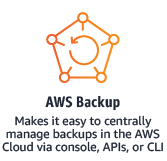
AWS Backup is a new cloud service that will helps you create your backups across your entire enterprise. It’s entirely possible to create backups using the built-in snapshot functions in the AWS services, but to do so for an entire business would mean an endless amount of work. Used in coordination with these snapshot utilities, AWS Backup lets you save data from EBS, EFS, RDS, DynamoDB, and Storage Gateway to Amazon S3. You may even move the older generation backups in S3 to Amazon Glacier. With Storage Gateway, you may even add your on-site data into the backups you generate.
Backup rules
You may employ rules to determine backup schedule, frequency, and backup window. You can single out items for back up or have a policy save them by marking them with tags. By instituting life cycle rules, you can establish how stored backups may expire or be tiered. AWS Backup will also consolidate the snapshots and other related data into a recovery point. All your backups are grouped into what’s called a vault, which is then secured by a KMS key.
With this level of control, you may determine how what your back up strategy will be on a regular basis, and ascertain that your data will be backed up exactly how you want it. You will also be able to restore data when you need it.
Notes
- Other services will be included with the Backup service over time. For now, it supports EBS, RDS, DynamoDB, EFS and Storage Gateway.
- You may use the AWS Command Line Interface (CLI) and AWS Backup APIs to access all of AWS Backup’s functions.
- You may use AWS Backup within an AWS Region. Currently planned enhancements include cross-region functionality.
- Finally, you are charged the regular charges for backups made with the built-in snapshot function. With Amazon EFS, there’s a small charge per GB for warm storage and a much lower one for cold storage.
AWS Backup is ready for use. Start backing up on the cloud today!
